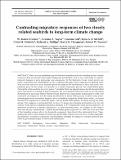Files in this item
Contrasting migratory responses of two closely-related seabirds to long-term climate change
Item metadata
| dc.contributor.author | Grecian, W. James | |
| dc.contributor.author | Taylor, Graeme A. | |
| dc.contributor.author | Loh, Graeme | |
| dc.contributor.author | McGill, Rona A. R. | |
| dc.contributor.author | Miskelly, Colin M. | |
| dc.contributor.author | Phillips, Richard A. | |
| dc.contributor.author | Thompson, David R. | |
| dc.contributor.author | Furness, Robert W. | |
| dc.date.accessioned | 2017-05-08T16:30:09Z | |
| dc.date.available | 2017-05-08T16:30:09Z | |
| dc.date.issued | 2016-11-09 | |
| dc.identifier | 249951353 | |
| dc.identifier | df960e08-4f87-43ea-b2f3-60a3a18e743e | |
| dc.identifier | 84994756758 | |
| dc.identifier.citation | Grecian , W J , Taylor , G A , Loh , G , McGill , R A R , Miskelly , C M , Phillips , R A , Thompson , D R & Furness , R W 2016 , ' Contrasting migratory responses of two closely-related seabirds to long-term climate change ' , Marine Ecology Progress Series , vol. 559 , pp. 231-242 . https://doi.org/10.3354/meps11875 | en |
| dc.identifier.issn | 0171-8630 | |
| dc.identifier.other | ORCID: /0000-0002-6428-719X/work/32706772 | |
| dc.identifier.uri | https://hdl.handle.net/10023/10726 | |
| dc.description.abstract | Many marine predators migrate between breeding and non-breeding areas to target resources that are seasonal but spatio-temporally predictable, and so are vulnerable to climate-induced changes in prey phenology and abundance. In the Southern Ocean, small petrels are major consumers, but perturbations in the ecosystem through ocean warming are altering food-web structure and have been linked to poleward shifts in the distribution of their cold-water zooplankton prey. In this study, we focused on 2 small congeneric petrels: the broad-billed prion Pachyptila vittata and the Antarctic prion P. desolata. Both are planktivorous, but the broad-billed prion specialises in feeding on large copepods. We investigated historical trends in non-breeding distribution by analysing feather stable isotope ratios from a time-series dating back to 1926, and examined contemporary non-breeding distributions of broad-billed prions tracked using miniaturised geolocation-immersion loggers. After controlling temporally for the Suess effect, we found that the δ13C signatures of Antarctic prions, but not broad-billed prions, declined during the study period. This suggests a southward shift in Antarctic prion non-breeding distribution over the last century. Both species exhibited significant declines in δ15N during the same period, indicative of long-term decreases in marine productivity in their moulting areas, or changes in the trophic structure of prey communities. Tracked broad-billed prions migrated ca. 1000 km to an area east of the breeding colony where the Louisville seamount chain bisects the subtropical front. Topographically driven upwellings are stable and predictable features and may be crucial in aggregating plankton. Targeting seamounts could therefore mitigate the impact of climate-induced prey shifts by providing refugia for the broad-billed prion. | |
| dc.format.extent | 12 | |
| dc.format.extent | 1199183 | |
| dc.language.iso | eng | |
| dc.relation.ispartof | Marine Ecology Progress Series | en |
| dc.rights | © The Authors 2016. Open Access under Creative Commons by Attribution Licence. Use, distribution and reproduction are unrestricted. Authors and original publication must be credited. | en |
| dc.subject | Biologging | en |
| dc.subject | Conservation | en |
| dc.subject | Migration | en |
| dc.subject | Moult | en |
| dc.subject | Movement | en |
| dc.subject | Non-breeding behaviour | en |
| dc.subject | Seamounts | en |
| dc.subject | Stable isotopes | en |
| dc.subject | Upwelling zones | en |
| dc.subject | QH301 Biology | en |
| dc.subject | NDAS | en |
| dc.subject | SDG 13 - Climate Action | en |
| dc.subject | SDG 14 - Life Below Water | en |
| dc.subject.lcc | QH301 | en |
| dc.title | Contrasting migratory responses of two closely-related seabirds to long-term climate change | en |
| dc.type | Journal article | en |
| dc.contributor.institution | University of St Andrews.School of Biology | en |
| dc.contributor.institution | University of St Andrews.Sea Mammal Research Unit | en |
| dc.contributor.institution | University of St Andrews.Scottish Oceans Institute | en |
| dc.identifier.doi | 10.3354/meps11875 | |
| dc.description.status | Peer reviewed | en |
| dc.date.embargoedUntil | 2016-11-09 | |
| dc.identifier.url | http://eprints.gla.ac.uk/123065/ | en |
This item appears in the following Collection(s)
Items in the St Andrews Research Repository are protected by copyright, with all rights reserved, unless otherwise indicated.

